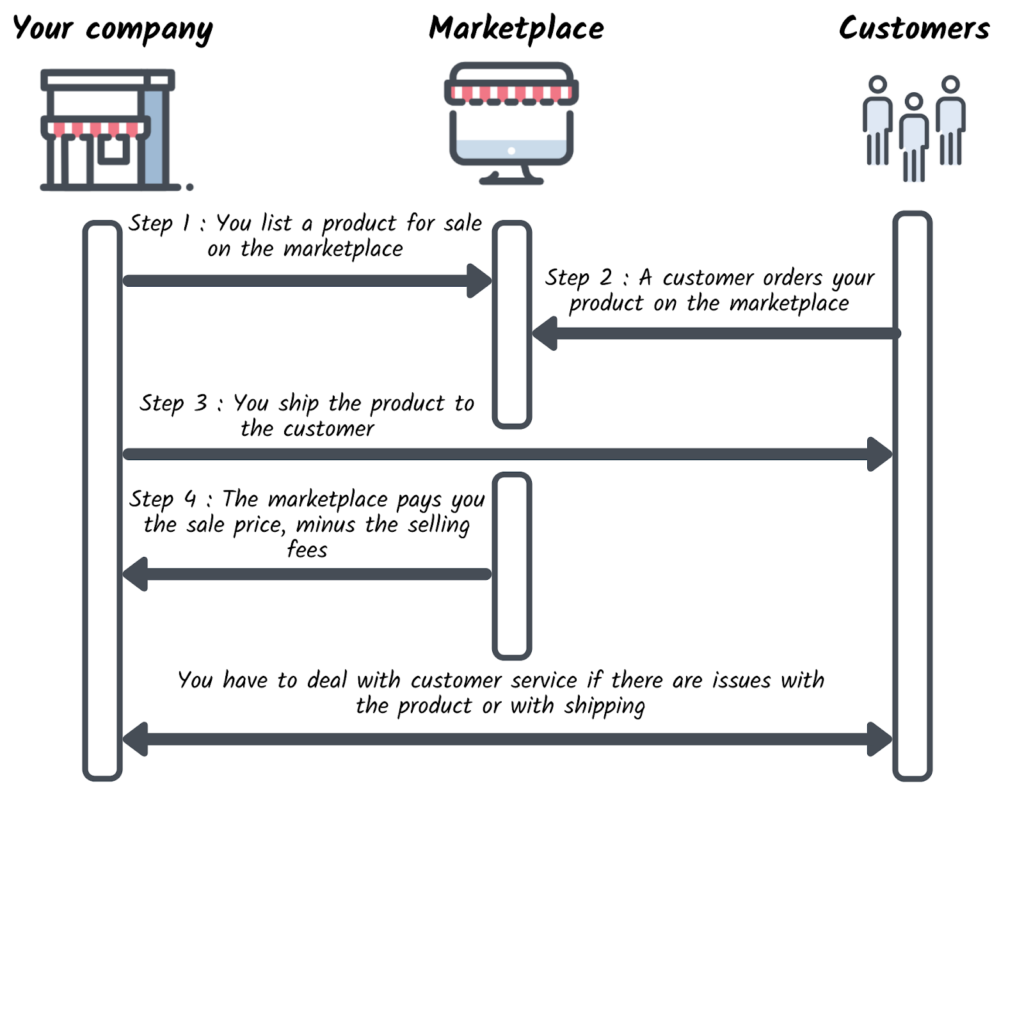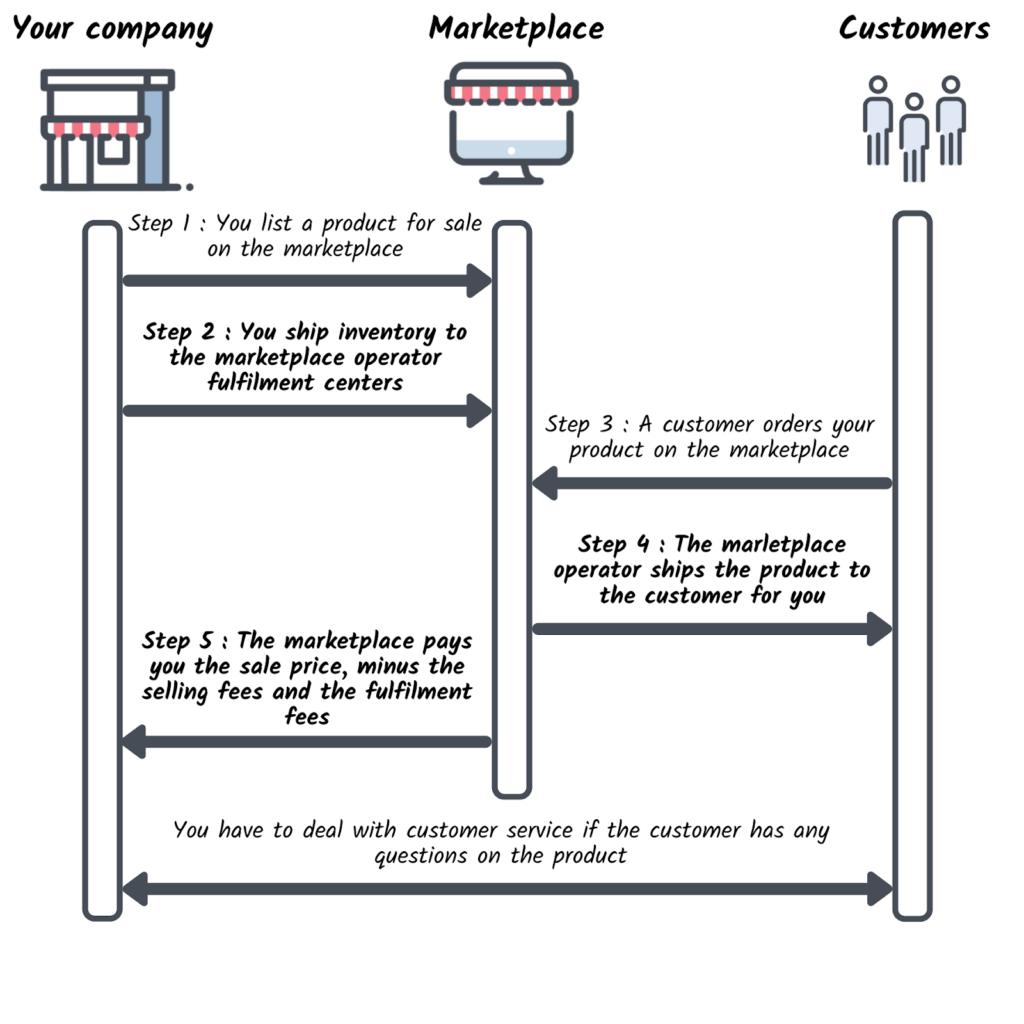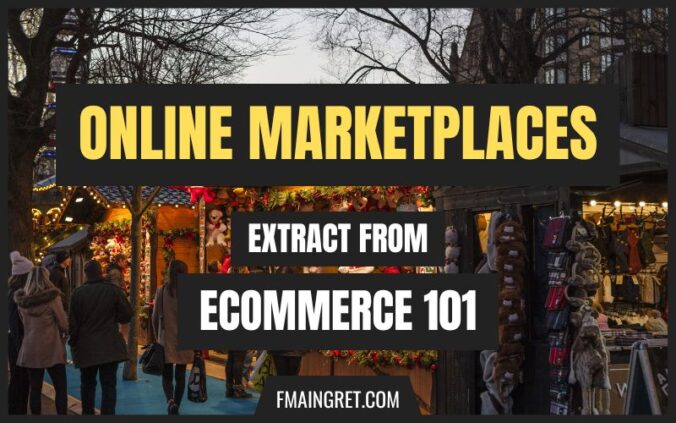The article below is an extract from my book Ecommerce 101. As the title implies, this is a book for people with no prior experience and knowledge of Ecommerce. This sections goes through the very basics of what online marketplaces are, how they work, and the pros/cons of selling on these platforms.
What are online marketplaces?

Companies register on the marketplace to offer customers their products or services. The marketplace operator usually charges sellers a fee on every sale. Some marketplace operators, like Walmart or Amazon, may sell their own items, along with third-party sellers. However, many marketplaces don’t even carry an inventory and make money by charging sellers subscriptions or selling fees. There are two main types of marketplaces: horizontal and vertical.
Marketplaces are now a huge part of the digital retailing world. These are platforms designed to facilitate the sale of products and services by multiple third-party sellers. Good examples of marketplaces are eBay, Amazon, or Etsy.
Vertical marketplaces
Vertical marketplaces focus on a single niche. For example, Etsy is a marketplace that primarily sells handmade goods, art, and craft items.
Horizontal marketplaces
Unlike the vertical model, horizontal marketplaces aim to offer a huge range of products in many categories. You can see these as the Walmart of marketplaces. For example, eBay offers millions of different products in hundreds of categories. Amazon used to focus on books, but they are now the largest marketplace with more than 300 million listings.
How does online marketplaces work?

Once you have a product to sell and you have registered your seller account on the marketplace, you can create a listing for your product (basically the equivalent of a product page). In most cases, especially if you have your own brand of products, you will need to write a product title, a product description, upload some images, and list all of the required technical information; you will also decide on a sale price.
After your product is live on the marketplace, hopefully one day, someone will come across your listing and buy your product, the customer will then pay the marketplace operator for the amount you asked.
Once the customer places the order, you will be notified and will be responsible for shipping the product to the customer.
The marketplace will pay you the amount the customer paid, minus any potential sale fees they might charge. For example, if you sell a lamp for $50 and the marketplace charges a 10% fee on every sale, the customer will pay $50, the marketplace will give you $45 and keep $5.
Finally, as the brand owner, you know your product better than anyone else, so you will be responsible for answering any questions the customer may have. If you shipped the product, you will also have to answer the customers’ questions and deal with returns.
You might have heard of Amazon FBA (Fulfilled By Amazon). That is one of the first things you find when you search for Ecommerce online courses. It is almost as popular as dropshipping; people selling courses are probably making a lot more money selling their course rather than their “FBA business”. Is it an easy and risk-free way to become a multi-millionaire in less than 6 months, like some gurus claim? Probably not. But Amazon FBA is still an interesting opportunity for many businesses.
So, what is FBA? Amazon gives you the option to use their fulfillment and shipping services. You ship your inventory to Amazon and store it at their fulfillment centers. Once a customer orders one of your products, Amazon will ship it for you, and charge you fulfillment fees. This way, you can focus on sales, marketing and advertising, and save time (and maybe money too) on shipping and order fulfillment. Amazon FBA is the most popular program, but other marketplaces are setting up their fulfillment services too, like Walmart with their WFS (Walmart Fulfillment Services) program. If you use fulfillment services on a marketplace, the process looks like this:

Now that you see how selling on a marketplace works, you need to decide whether you should do it or not. Let’s look at the pros and cons of marketplaces.
Pros and Cons of online marketplaces
Pros
Traffic: Large marketplaces attract tons of customers. Millions of customers shop on Amazon or Etsy every month, and these numbers increase year after year. By listing your products on a popular marketplace, you should quickly have customers looking at your products. Getting started on your own website would take more time, as you would have to optimize SEO or invest in advertising before getting traffic or having any chance to make a sale.
Customer trust: Lots of customers would rather shop on popular marketplaces rather than on brand-specific Ecommerce websites. Some people might see marketplaces as more trustworthy, they might have a membership (for example, Amazon Prime so they don’t pay for shipping), have a gift card to use for that marketplace, or they might like to compare different offers on the same platform.
Easy to use: Once you register on a marketplace and your application is approved, it is usually very easy to start selling items. There is no need to design a whole website as these platforms make it super easy to create product pages. You don’t need any technical knowledge either to quickly start making sales. Many marketplaces also make the administrative part easier. For example, some marketplaces offer sales tax automation or make it easier to expand to other countries.
Fulfillment services: If you don’t have time to fulfill orders and working with a third-party warehouse is not an option, taking advantage of marketplaces fulfillment services can be extremely helpful. This way, you have more time to focus on sales, product development, and branding and you can let the experts take care of the logistics. Some of them offer really good deals on reliable shipping, so you can sometimes save a few bucks there.
Customer feedback: Because these marketplaces attract lots of customers who are used to writing product reviews, you should be able to get some great feedback on your products. This can be extremely helpful when developing a new version of a product, expanding your brand, finding out about production issues, or discovering some of your customers’ needs.
Cons
Competition: Unless you have a unique and hard-to-copy product (this would be the best-case scenario), you are competing directly with many other sellers when on a marketplace. Your competitors’ products will appear next to yours in the search results. Even on your listing, there might be a “Similar products” section, and the competitors’ products can even appear right next to your “Add to cart” button. This gives the customers the opportunity to easily compare product features, reviews, and prices. When the competition is tough, some companies will start a price war at some point (spoiler: price wars rarely end well). This isn’t too bad for strong brands or unique and hard-to-copy products, but for companies selling commodities, this is a huge problem. Another problem is that some competitors will see that your product is successful and might come up with their own version of it.
Branding: No matter what product page you are looking at, they all look pretty much the same on a marketplace. Sure, there might be different colors in the products’ pictures or some recognizable headlines, but these are all Amazon, eBay, or Walmart product pages, and you can’t change their structure. This is a problem because it is harder to differentiate yourself from your competitors, and you can’t always design the best product page structure for what you have to offer.
No data or personalization: Data is extremely valuable, and marketplace operators tend to keep most of it to themselves. If you’re lucky, they will tell you about your conversion rate or average cart value. But you will not know how many customers left during checkout, or if they also buy from your competitors. You will not be able to create personalized content either, even though customers love it. They are not your customers, but the marketplace operator’s customers. (Unless something goes wrong with their order. In that case, they are your customer and you are responsible for anything bad that happened).
No control: In my opinion, this is the worst part. You have no control over what the marketplace operator is doing. If they decide to double their fees overnight, there isn’t much you can do. They can change the search engine algorithm, and make your product almost invisible to customers. Or, if they decide they don’t want your company to sell on their platform anymore, they can shut down your account at any time. Thousands of companies that rely purely on Amazon go out of business every year because their account is permanently suspended. This is a huge risk, and putting your business fate in the hands of an outsourced entry-level analyst does not sound great.
As a conclusion, marketplaces are a great way to increase your sales, especially when you are getting started. You can take advantage of all the traffic these platforms attract and use their fulfillment services to save time. It is also very easy to set up. However, relying only on marketplaces is very risky. You don’t have control over the fees, the website structure, or the data you collect. Depending on your products and brand, it can be extremely competitive, and price wars are very common. The risk of being kicked out and losing a big part of your business is real. In most cases, having multiple income streams and sales channels is the best way to take advantage of the opportunities you have, while limiting the risks.

